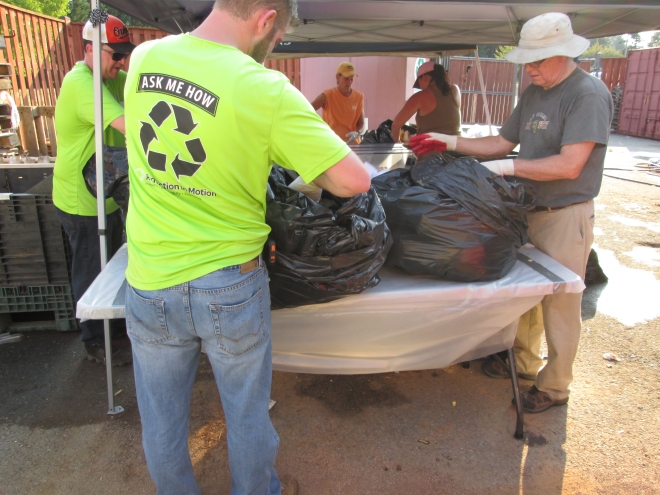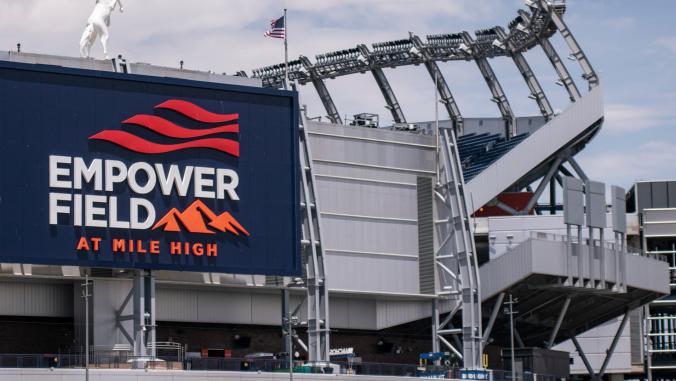Can talking trash actually make sports more sustainable?
Reduction In Motion’s Kelsey Hallowell is efficiently reducing waste with Baltimore athletics and helping fans go green.

Reduction In Motion’s Kelsey Hallowell works on waste management projects, such as one at the Baltimore Orioles' stadium.
Kelsey Hallowell is a professional trash talker.
She plies that unusual trade for Reduction In Motion, a forward-leaning waste reduction consultancy in Baltimore. One of Kelsey’s clients is the Maryland Stadium Authority which, among other things, owns Camden Yards (home of baseball’s Orioles) and M&T Bank Stadium (home of the NFL’s Ravens).
We talked to Kelsey, whose official title is communications and outreach coordinator, about the unique aspects of working with sports venues. And talking trash.
Lew Blaustein: I love your job title. How does one get to be a professional trash talker?
Kelsey Hallowell: For me it started out as a little girl in Duxbury, Massachusetts. I was always outside playing — the joke with my family is as a toddler, my parents would set me beside them as they gardened, and I would eat handfuls of dirt.
Blaustein: Uh … another way of saying you have "an appreciation for the environment."
Hallowell: Yes. Then I ended up attending Washington College, a small liberal arts school in Chestertown on the Eastern Shore of Maryland.
Blaustein: Sounds like an outdoorsy place.
Hallowell: It is. In fact, I got to be a part of the first cohort of something called the Chesapeake Semester. It was amazing. Rather than being stuck in a classroom, we went out into the environment, into the field to learn. Talked to and worked with farmers, scientists and historians for environmental causes throughout the Chesapeake Bay watershed.
Blaustein: What a great program. I can see how you would end up in the trash talking, waste reduction business.
Hallowell: Actually, I started in the recycling and waste world while at Washington College. I worked with the Center for Environment & Society (CES), which is linked with the college and Chestertown. CES focuses on social and environmental issues.
Blaustein: What was your role?
Hallowell: I worked on a variety of projects. Not too surprisingly, I was one of a handful of students who helped with recycling on campus. We got into the nitty-gritty of it, which was a great experience.
Blaustein: What do you mean by nitty-gritty?
Hallowell: We collected the recycling by hand, separating glass by color, while also separating plastics, metals, paper and cardboard. We also helped to reinvigorate composting on campus and started a campus garden.
Blaustein: Not glamorous but it sounds like a great training ground. … What did you do once you graduated?
Hallowell: While I was still at Washington College, I went to a presentation by an alum who worked at Reduction In Motion. I thought, "What they do is really cool." One thing led to another and, in 2012, I became a trash talker at Reduction In Motion.
Blaustein: So what does Reduction In Motion do?
Hallowell: The company was started in 2002 by Bill Griffith. He worked for a long time in the hazardous and medical waste industry. He saw how much waste went into the red bags designated for regulated medical waste and how much of that didn’t really belong there. Bill also realized that hospitals — and many other types of businesses and venues — really had very little idea about their waste: how much they generate, where it goes, how much it costs…
Blaustein: How could hospitals not know how much their waste hauling cost?
Hallowell: That’s what Bill asked. So he launched the company to help hospitals and other healthcare facilities understand their waste streams better, more efficiently deal with it and save money by doing so. I started as a greening facilitator for hospitals in Baltimore City.

Bill Griffith, founder of Reduction In Motion, taking part in a waste audit. (Photo credit: Reduction In Motion)
Blaustein: What is a greening facilitator?
Hallowell: I basically helped the "waste generators" — clinicians, administrative staff, food service and waste handlers (housekeeping and facilities) — make sure the different types of waste went into the correct waste or recycling stream.
Blaustein: How did the doctors and hospital staff react?
Hallowell: Some were really into it, some not so much. A few hospitals really got it. One had an already-established Green Team by the time we arrived. We worked with them to use compost to help fertilize a garden they had established.
Blaustein: That sounds like a real success.
Hallowell: It was. We’ve found that one of the keys to success for our clients is to stick to the basics: What and how much waste are you generating? With recycling, what kind of bins do you have? Is signage clearly communicating what goes into which bin? Are you following where the waste and recycling goes after it leaves your premises?
Blaustein: Simple, yet important.
Hallowell: That’s really it. Set it up and help maintain the program.
Blaustein: You then moved up from greening facilitator to your current trash talking position: communications and outreach coordinator. What does that entail?
Hallowell: Well, we’re a small operation with less than 10 employees, so the job has a bit of everything in it. I help support our clients, from Virginia to New Jersey, with educational materials and the aforementioned signage. Management of our website and social media, developing presentations and supporting sales are also parts of my day-to-day.
Blaustein: Sounds busy and also varied. Now, what is the Reduction In Motion business model?
Hallowell: Good question. We call ourselves "waste-based sustainability consultants," and we mostly work on a monthly fee basis. Recently, a project-specific model has become popular.
We show cost savings to our clients by increasing the amount of waste that goes to recycling and composting and cutting the amount that goes to trash, because sending waste to landfills is more expensive. Our metrics for success are diversion rates and money saved. But things have gotten much more challenging recently.We show cost savings to our clients by increasing the amount of waste that goes to recycling and composting. ... Sending waste to landfills is more expensive.
Blaustein: Why is that?
Hallowell: Recycling just became infinitely more difficult because China — where the U.S. and many other countries sent most of its recycled material — enacted a new law, banning the import of American recycling because there was too much contamination.
Blaustein: I heard something about that. How much contamination is too much?
Hallowell: It needs to be less than 0.5 percent but the U.S. was sending recycling to China with contamination rates north of 15 percent. That’s one big reason why we emphasize examining waste streams at the client site to make sure they’re not contaminated.
Blaustein: So where’s the recycling going to go if not China? Can we keep it here?
Hallowell: Great question. The domestic recycling infrastructure needed to support the recovery of the materials we were previously sending to China needs to be greatly expanded if we are going to keep it all here. To truly fix the issues the recycling industry is facing today, manufacturers need to get involved. How2Recycle.info is a great website that explains not only the confusion consumers are facing when trying to recycle but it also addresses how to solve the problem. We need standardized, clear, concise messaging included on the products we buy every day. All packages should be labeled so the consumer can quickly and easily determine how to dispose of everything the package contains the right way.
Think of a box of cereal. There is the outer box and the inner bag containing the cereal. Most consumers are well aware that the outer box can be recycled but get confused when it comes to the inner bag. They think, "It’s plastic, so it can go into the recycle bin, too," but that’s just not the case. This could be solved if a label was printed on the outside of the box in an easily viewable spot, clearly explaining that the box is recyclable but the plastic bag is not. Standardization of information labels on packaging materials will do a great deal to cut down on contamination rates found in today’s recycling stream. Once the disposal of packaging materials has been standardized, the materials recovery facilities (MRFs) can get to work on how best to recover the materials here in the U.S., increasing jobs and eliminating the need to export recycled material out of the country.
Blaustein: We should do a separate interview about what needs to happen to build domestic recycling infrastructure. But for now, let’s talk about how Reduction In Motion got into working with sports venues.
Hallowell: Sports venues are different from hospitals. Hospitals run and generate waste 24-7. Sports fans are at a venue for a few hours and not every day. But when they do go to a game, they generate huge amounts of waste in a relatively short time. Our first sports clients were two minor league baseball teams in Maryland, Aberdeen IronBirds, who play at Ripken Stadium, and the Frederick Keys, whose home base is Harry Grove Stadium. We received a grant from the state to conduct waste audits for them. From there, we moved up to the big leagues as we started to work with the Maryland Stadium Authority. It operates Camden Yards, the home of the Orioles, and M&T Bank Stadium, home of the Ravens.

Reduction In Motion team members and volunteers sort trash and recycling generated at a Frederick Keys game at Harry Grove Stadium as part of a grant-funded project by Maryland Department of the Environment in 2015. (Photo credit: Reduction In Motion)
Blaustein: What do you do for them?
Hallowell: We conducted waste audits as part of both stadiums’ LEED certification efforts, including identifying all the waste that’s generated, from plastic to metal to glass to compostables and more. That led to us working with the stadium authority to help the venues understand and improve their diversion rates. We developed fan and staff education content about which types of waste goes into what bin.
Blaustein: I know there are studies saying that fans care about the environment but do they really care about putting the right type of waste into the right bin?
Hallowell: Some do but some don’t. That’s why it’s so important to establish and roll out a plan, then continue to engage with the key stakeholders, like leadership, operations teams and the fans. By focusing on bin selection, placement, color-codes and messaging, we try to make it as easy as possible for fans to do the right thing.
This approach allowed us to help the University of Richmond with its 2017 "Rethink Waste" basketball game: Recycling contamination was reduced by 54 percent from their baseline and compost was collected at a 93 percent compliance rate. For more details on how we did it, you can read the full story here.The truth is it’s easier to do the right thing if we make it easy.
Blaustein: So that’s where talking trash comes in.
Hallowell: You got it! The truth is it’s easier to do the right thing if we make it easy.
Blaustein: So true. How are Camden Yards and M&T Bank Stadium doing, diversion rate-wise?
Hallowell: Both have improved over the past several years. Camden Yards’ diversion rate increased from 10 percent in 2012 to 30 percent in 2017. M&T Bank Stadium is doing great; in 2017 it was up to a 58 percent diversion rate, an increase of 40 percent since 2011. Similarly, we’ve had good success in the college sports world. We helped the University of Richmond achieve an 87 percent landfill diversion rate at the aforementioned "Rethink Waste" basketball game.

Reduction In Motion and University of Richmond’s student volunteers conducting waste audits during a 2017 Spiders men’s basketball game. (Photo credit: Reduction In Motion)
Blaustein: Wow! Congratulations. You make this sound easy but I know it isn’t. What factors might hold down a sports venue’s diversion rate?
Hallowell: Buy-in and consistency. Ensuring you have an understanding of the operations while getting leadership’s understanding and approval can be a tricky balance, and that’s where we come in. Recycling seems easy, but achieving a high, uncontaminated diversion rate will take time and energy. And it takes even more time and energy to maintain and further improve your diversion rates. Things are always changing, whether it be the workforce, those in leadership roles, and, as seen in the China case, the rules of recycling.
Blaustein:: Stadium workers have tough jobs so the communications have to be powerful and the incentives need to be real for them to consistently do the right thing regarding waste. Is sports a growing sector for Reduction In Motion?
Hallowell: It is. More and more, pro and college teams and venues are embracing sustainability — we saw that phenomenon in person at the Green Sports Alliance Summit in Atlanta last month. We also see that fan engagement on recycling and other environmental initiatives is on the rise. In fact, we are providing guidance and ideas to the Maryland Stadium Authority on fan engagement.
This story first appeared on:





